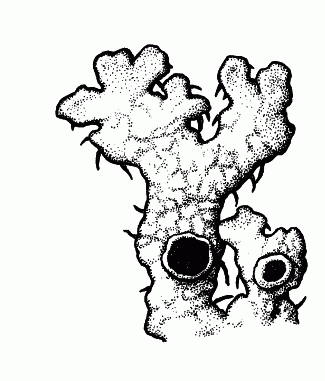Physcia phaea (Tuck.) Thomson
black-eyed rosette
Physciaceae
Introduction to the Lichens
black-eyed rosette
Physciaceae
Introduction to the Lichens
Map
Distribution of Physcia phaea unavailable
Species Information
General:
Common Name: The Rosette Lichens. Describes the centrifugal growth form characteristic of many of the species.
Small to occasionally medium stratified foliose lichens, corticate above and below, sorediate or isidiate or not, lobes closely appressed to loosely attached, elongate-linear to elongate, averaging to 0.5–2 (–3) mm wide, thin. Upper surface usually pale whitish grey, rarely darker, K+ yellow, white-pruinose or white-spotted, dull. Lower surface pale to blackish, dull, bearing scattered, short, simple rhizines. Medulla white. Photobiont green.
Apothecia located over upper surface, disc white-pruinose to black; spores 2-celled, ellipsoid, brown, 8 per ascus.
Over acid or especially calcium-rich substrates, including rock, soil, duff, bark and bone.
Notes: Thirty species of Physcia are reported for North America and 11 of these are known to occur in B.C. Physcia has been subdivided into several segregate genera, including Phaeophyscia and Physconia.
Species description:
Lobe margins lacking cilia (Note: marginal rhizines may occur in some species, but these average to less than 0.8 mm long); lobe tips appressed AND
Thallus lacking soredia, isidia and lobules AND
Upper surface never distinctly white-pruinose throughout (pruina, if present, confined to area of the lobe tips), pale or darkening, often distinctly pale-spotted; ecology, distribution and chemistry various AND
Over other substrates, including rock, bone, mosses over rock; medulla K+ yellow AND
Apothecial discs dark, not at all white-pruinose; upper surface often darkening toward thallus centre; mature spores usually less than 17 m long
Comments:
Pale, coastal forms of P. phaea with inconspicuous white-spotting are sometimes referred to P. cascadensisMagnusson. The spores in P. phaea are smaller than those in the closely related P. aipolia. This character is sometimes difficult to apply because of overlap in spore size. Typical spore lengths in the B.C. material are 16–18 (–20) m for P. phaea and 17–25 m for P. aipolia.
Reactions:
Cortex K+ yellow; medulla K+ yellow.
Contents:
Atranorin and zeorin.
Source: Lichens of British Columbia
Illustration

If more than one illustration is available for a species (e.g., separate illustrations were provided for two subspecies) then links to the separate images will be provided below. Note that individual subspecies or varietal illustrations are not always available.
Illustration By: Trevor Goward
Habitat and Range
Habitat: Infrequent over acid rock in open inland sites at lower elevations, also rare in lowland maritime localitiesWorld Distribution: N Am – western Eurasia, N to AK, S to CA.
Source: Lichens of British Columbia
Status Information
Synonyms
Synonyms and Alternate Names:
Physcia melops Nyl.